#Fujitsu Interactive
Explore tagged Tumblr posts
Text

USA 1997
650 notes
·
View notes
Text





[もうぢや] / Etona, Fujitsu Pasokon Systems, Racdym / 1997
0 notes
Text
The song is "clock of phinphin" from the game 'Fin Fin on Teo the Magic Planet', a 1996 windows game developed and published by Fujitsu Interactive, Inc. Released on Windows.
youtube



-Submission by @raptorbricks
19 notes
·
View notes
Text
AIMA Professional Development | Enhancing Management Skills & Competencies
GAMP is designed to help business leaders get insights into the emerging trends/business models and will focus on open innovation strategies that will help deal with the current VUCA environment also prepare for future scenarios. The format of the programme includes Case Discussions, Presentations, Executive Panels and visits to and interaction with the top management teams of some of the most innovative companies and institutions in US Silicon Valley. Some companies visited in the past include NVidia, Chevron, Paypal, Standard Chartered Bank, Wells Fargo Bank, PG&E, DuPont Innovation Center, Calpine Corporation, Cisco Systems, Wipro, IBM Almaden Research, Plug & Play Innovation Center, Fujitsu Laboratories, Berkeley SkyDeck, UC Berkeley Campus amongst others. For More Information Please Visit Our Website:-
0 notes
Text
Retail Automation Market Sees Technological Innovation Reshaping Traditional Retail and Consumer Interaction
The retail automation market is undergoing a remarkable transformation driven by technological advancements, evolving consumer preferences, and the increasing need for operational efficiency. Retailers across the globe are embracing automation solutions to enhance customer experiences, reduce costs, streamline operations, and stay competitive in an increasingly digital economy. This rapid adoption is significantly reshaping the retail landscape across both developed and emerging markets.

Market Overview
Retail automation involves the use of technology to automate retail processes such as inventory management, billing, customer engagement, and product tracking. It includes a wide range of solutions such as self-checkout systems, vending machines, electronic shelf labels (ESLs), barcode and RFID systems, interactive kiosks, and automated storage and retrieval systems (AS/RS). These solutions not only reduce dependency on manual labor but also improve accuracy, speed, and customer satisfaction.
The global retail automation market has seen robust growth over the past few years. As of 2024, the market size is valued at over USD 20 billion and is projected to surpass USD 35 billion by 2030, growing at a CAGR of over 8% during the forecast period. This growth is largely driven by advancements in AI, IoT, robotics, and cloud computing.
Key Drivers of Growth
Increased Consumer Demand for Contactless Shopping The COVID-19 pandemic accelerated the adoption of contactless technologies. Customers today prefer minimal physical interaction, which has driven retailers to invest in self-checkout systems and mobile payment solutions. These technologies also reduce wait times and improve convenience.
Rising Labor Costs and Labor Shortages Retailers are increasingly facing labor-related challenges, especially in developed countries. Automation offers a sustainable alternative by minimizing human error and lowering operating costs in the long run.
Data-Driven Decision Making Retail automation tools collect vast amounts of real-time data that help retailers make informed decisions regarding inventory levels, customer preferences, and product placement. AI-powered analytics tools enhance this further by providing predictive insights.
Enhanced In-Store Experience Interactive kiosks, smart mirrors, and AR/VR technology allow retailers to provide immersive shopping experiences that improve customer engagement and satisfaction, helping brick-and-mortar stores compete with e-commerce.
Market Segmentation
The retail automation market can be segmented by product type, end-user, and region.
By Product Type: Point-of-sale (POS) terminals, barcode & RFID systems, electronic shelf labels, self-checkout systems, and vending machines.
By End-User: Supermarkets, hypermarkets, convenience stores, fuel stations, and online retailers.
By Region: North America holds the largest market share, followed by Europe and Asia-Pacific. However, the Asia-Pacific region is expected to witness the fastest growth due to increasing urbanization, rising disposable incomes, and rapid digitalization in countries like China and India.
Competitive Landscape
The market is highly competitive and fragmented. Major players include Honeywell International Inc., Fujitsu Limited, Diebold Nixdorf, Zebra Technologies, NCR Corporation, and Toshiba Global Commerce Solutions. These companies are investing heavily in R&D and forming strategic partnerships to expand their product offerings and reach.
Startups are also playing a significant role by introducing innovative solutions, particularly in AI-driven analytics and cashier-less checkout technologies. Amazon Go is a notable example, setting new benchmarks for automation in retail environments.
Challenges and Limitations
Despite the benefits, the adoption of retail automation is not without challenges. High initial investment costs can be a barrier for small and medium-sized enterprises (SMEs). There are also concerns around data privacy, cybersecurity, and job displacement. Retailers must ensure a balanced integration of automation and human labor to maintain both efficiency and customer trust.
Future Outlook
The future of the retail automation market looks promising. Emerging technologies such as AI, machine learning, robotics, and edge computing will continue to drive innovation. Personalization will become a key focus, with automation enabling hyper-personalized shopping experiences tailored to individual consumer behavior.
Moreover, sustainability will play an increasing role, with automated systems helping reduce waste and optimize energy consumption in stores. As competition intensifies and consumer expectations rise, retailers that strategically invest in automation will be better positioned to succeed in the evolving landscape.
0 notes
Text
How will changing consumer shopping habits shape the evolution of self-checkout solutions
The Self-Checkout Systems Market was valued at USD 4.62 Billion in 2023 and is expected to reach USD 15.49 Billion by 2032, growing at a CAGR of 14.42% over the forecast period 2024-2032.
Self-checkout Systems Market is rapidly transforming the global retail experience as businesses increasingly invest in automation to enhance efficiency and customer satisfaction. With major supermarkets, convenience stores, and pharmacies adopting these systems, retailers are reducing wait times and labor costs while offering faster and more personalized shopping experiences.
U.S. Market Surge: The U.S. leads global adoption, driven by labor shortages, rising operational costs, and growing consumer preference for self-service technology
Self-checkout Systems Market continues to expand as evolving consumer expectations drive demand for seamless, contactless transactions. The integration of AI, machine vision, and mobile wallet compatibility further strengthens the market, especially in tech-forward regions like North America and Europe.
Get Sample Copy of This Report: https://www.snsinsider.com/sample-request/2784
Market Keyplayers:
NCR Corporation (Self-Checkout Kiosks, POS Systems)
Diebold Nixdorf (Vynamic Software, Self-Service Kiosks)
Toshiba Global Commerce Solutions (Self-Checkout Solutions, POS Terminals)
Zebra Technologies (Self-Checkout Solutions, Mobile Point of Sale)
Panasonic Corporation (Self-Checkout Kiosks, POS Solutions)
Fujitsu Limited (Self-Checkout Systems, POS Terminals)
HP Inc. (Self-Checkout Kiosks, Retail Solutions)
TPI Software (Self-Checkout Software Solutions, Retail Management Software)
Kiosk Information Systems (Self-Checkout Kiosks, Interactive Kiosks)
SZZT Electronics (Self-Checkout Systems, Payment Terminals)
Wincor Nixdorf (Self-Checkout Systems, Cash Management Solutions)
Coinstar (Self-Service Coin Machines, Kiosk Solutions)
VivaKi (Self-Checkout Kiosks, Digital Signage Solutions)
Intuit (Self-Checkout Solutions, Point of Sale Software)
AURES Technologies (Self-Checkout Systems, POS Hardware)
Datalogic (Self-Checkout Scanners, Retail Automation Solutions)
SATO Holdings Corporation (Self-Checkout Solutions, Labeling Solutions)
NEXTEP SYSTEMS (Self-Service Kiosks, Digital Signage)
MHI (Self-Checkout Solutions, Retail Management Software)
PayRange (Mobile Payment Solutions, Self-Service Kiosks)
Market Analysis
Retailers are rethinking their in-store operations to accommodate increasing customer demand for speed and autonomy. Self-checkout systems have emerged as a critical retail technology—streamlining checkout processes and minimizing human error. The pandemic accelerated the shift toward contactless solutions, and that momentum has only intensified post-COVID. Large chains in the U.S. and Europe are deploying scalable self-checkout kiosks to meet rising demand while integrating advanced technologies for fraud detection and user assistance.
Market Trends
Surge in AI-powered checkout systems with item recognition
Growth in mobile and app-based self-scanning solutions
Implementation of biometric authentication and facial recognition
Expansion of hybrid checkout systems (manned + self-checkout)
Focus on theft reduction via weight sensors and computer vision
Integration with loyalty programs and digital coupons
Demand for multilingual interfaces and accessibility features
Market Scope
The market is expanding rapidly beyond grocery stores into sectors like apparel, hardware, and hospitality. Self-checkout systems are no longer limited to big-box retailers; even small businesses are investing in compact and affordable solutions.
Wide adoption in retail, QSR, and airport kiosks
Enhanced data analytics for inventory and footfall tracking
Real-time support via AI chatbots and remote monitoring
Customizable UI to match brand identity and customer demographics
Strong investment in modular, space-saving designs
Forecast Outlook
The future of the Self-checkout Systems Market is highly promising, shaped by innovations in AI, edge computing, and IoT integration. Retailers across the U.S. and Europe are expected to continue prioritizing self-service technologies as a strategic investment. As customer satisfaction, operational agility, and profitability converge, self-checkout will become a core component of retail modernization. Enhanced fraud prevention and real-time data feedback will further solidify its role in retail strategy.
Access Complete Report: https://www.snsinsider.com/reports/self-checkout-systems-market-2784
Conclusion
Self-checkout technology is no longer a novelty—it's a necessity. Retailers seeking to remain competitive must embrace intelligent, user-friendly systems that align with modern consumer expectations. With the U.S. and European markets setting the pace, the self-checkout industry is poised to redefine in-store experiences. The future belongs to fast, frictionless, and flexible retail, and self-checkout systems are leading the way.
Related Reports:
U.S.A Media Asset Management Market Set to Witness Dynamic Growth Across Digital Platforms
U.S.A Intelligent Transportation System Market Poised for Technological Disruption and Growth
U.S.A Conversational Systems Market Witnesses Rising Adoption of AI-Powered Interfaces
About Us:
SNS Insider is one of the leading market research and consulting agencies that dominates the market research industry globally. Our company's aim is to give clients the knowledge they require in order to function in changing circumstances. In order to give you current, accurate market data, consumer insights, and opinions so that you can make decisions with confidence, we employ a variety of techniques, including surveys, video talks, and focus groups around the world.
Contact Us:
Jagney Dave - Vice President of Client Engagement
Phone: +1-315 636 4242 (US) | +44- 20 3290 5010 (UK)
Mail us: [email protected]
0 notes
Text
Self-Service Kiosks Market Size, Share, Trends, Opportunities, Key Drivers and Growth Prospectus
"Global Self-Service Kiosks Market - Size, Share, Demand, Industry Trends and Opportunities
Global Self-Service Kiosks Market, By Type (Indoor Self-Service Kiosk and Outdoor Self-Service Kiosk), Implementation (Point-of-Information, Product Promotion, Service or Transaction, Internet Commerce, Product Dispensing and Others), Usage (Checkin-Checkout, Advertising, Navigation, Recruitment, Photos, Inventory Management, Employee Information, Reservations, Ticket Printing, Patient Service, Bill Payments, Food Ordering, Registration and Identification and Others), End User (Retail, Travel and Tourism, Healthcare, Entertainment, Financial Services and Others) and Country (U.S., Canada, Mexico, Brazil, Argentina, Rest of South America, Germany, Italy, U.K., France, Spain, Netherlands, Belgium, Switzerland, Turkey, Russia, Rest of Europe, Japan, China, India, South Korea, Australia, Singapore, Malaysia, Thailand, Indonesia, Philippines, Rest of Asia-Pacific, Saudi Arabia, U.A.E, South Africa, Egypt, Israel, Rest of the Middle East and Africa) Industry Trends
Access Full 350 Pages PDF Report @
**Segments**
- **Type:** The self-service kiosks market can be segmented based on the type of kiosks, including information, ticketing, check-in, employment, banking, patient registration, and others. Each type serves a specific purpose, such as self-checkout kiosks in retail stores or ticketing kiosks at airports and cinemas.
- **Component:** Segmentation based on components includes hardware, software, and services. The hardware components may include touch screens, displays, printers, and others, while software involves the operating system and applications crucial for kiosk functionality. Services may cover installation, maintenance, and support.
- **End-User:** The market can be segmented by end-users into retail, healthcare, banking, entertainment, travel, government, and others. Each sector utilizes self-service kiosks differently, with retail focusing on enhancing customer experience, healthcare streamlining patient registration, and banking for faster transactions.
**Market Players**
- **NCR Corporation**: NCR Corporation offers self-service kiosks for various industries, including retail, banking, and hospitality. Their advanced technology and solutions have made them a key player in the market.
- **Diebold Nixdorf**: Diebold Nixdorf is a global leader in providing self-service kiosks, ATMs, and other automated solutions for a multitude of sectors. Their innovative approach and reliable products have solidified their position in the market.
- **Fujitsu Limited**: Fujitsu Limited is known for its robust self-service kiosks that cater to different industries. Their focus on cutting-edge technology and user-friendly interfaces has garnered them a significant market share.
- **IBM Corporation**: IBM Corporation offers self-service kiosks with advanced features for improved efficiency and customer interaction. Their integration of AI and data analytics sets them apart in the market.
- **Olea Kiosks**: Olea Kiosks specializes in custom self-service kiosk solutions tailored to the specific needs of clients.The self-service kiosks market is witnessing significant growth and transformation driven by technological advancements and the rising demand for efficient customer service solutions across various industries. As market players such as NCR Corporation, Diebold Nixdorf, Fujitsu Limited, IBM Corporation, and Olea Kiosks continue to innovate and provide cutting-edge solutions, the market landscape is evolving rapidly. Each company brings its unique strengths and capabilities to the table, catering to a diverse range of industries and end-users.
NCR Corporation is a prominent player in the self-service kiosks market, known for its comprehensive offerings across retail, banking, and hospitality sectors. The company's focus on advanced technology and tailored solutions has allowed it to carve out a niche for itself in the competitive market. NCR's self-service kiosks are designed to enhance customer experiences, streamline operations, and drive efficiency for businesses.
Diebold Nixdorf stands out as a global leader in automated solutions, including self-service kiosks and ATMs. The company's innovative approach to self-service technology and commitment to reliability have positioned it as a key player in the market. Diebold Nixdorf's wide range of self-service kiosk offerings caters to diverse industries, allowing businesses to streamline processes and improve customer interactions.
Fujitsu Limited's robust self-service kiosks are known for their cutting-edge technology and user-friendly interfaces. The company's emphasis on innovation and customer-centric solutions has helped it capture a significant market share. Fujitsu's self-service kiosks are tailored to meet the specific needs of different industries, providing seamless and efficient self-service options for businesses and customers alike.
IBM Corporation brings its expertise in AI and data analytics to the self-service kiosks market, offering advanced features that drive efficiency and enhance customer interactions. By integrating AI technologies into their kiosk solutions, IBM allows businesses to leverage data insights to optimize operations and deliver personalized experiences. IBM's focus on innovation and technology solutions sets it apart in the competitive market landscape**Global Self-Service Kiosks Market Analysis**
- **Segments:** The self-service kiosks market can be segmented into indoor and outdoor kiosks based on type, with various implementations such as point-of-information, product promotion, service/transaction, internet commerce, product dispensing, and more. Different usage scenarios include check-in/check-out, advertising, navigation, recruitment, inventory management, ticket printing, and others. End-users span across retail, travel, healthcare, entertainment, financial services, and other sectors.
- **Market Players Analysis:** NCR Corporation, Diebold Nixdorf, Fujitsu Limited, IBM Corporation, and Olea Kiosks are key players in the self-service kiosks market. These companies offer advanced technology solutions tailored to various industries, enhancing customer experiences, streamlining operations, and driving efficiency. NCR Corporation focuses on comprehensive offerings for retail, banking, and hospitality sectors. Diebold Nixdorf's innovative approach and reliability have solidified its global leadership. Fujitsu Limited's emphasis on cutting-edge technology and user-friendly interfaces has captured a significant market share. IBM Corporation integrates AI and data analytics into kiosk solutions for improved efficiency and customer interactions, while Olea Kiosks specializes in custom solutions for diverse client needs.
The self-service kiosks market is experiencing rapid growth and transformation driven by technological advancements and increasing demand for efficient customer service solutions. The market landscape is evolving as companies like NCR Corporation, Diebold Nixdorf, Fuj
Core Objective of Self-Service Kiosks Market:
Every firm in the Self-Service Kiosks Market has objectives but this market research report focus on the crucial objectives, so you can analysis about competition, future market, new products, and informative data that can raise your sales volume exponentially.
Size of the Self-Service Kiosks Market and growth rate factors.
Important changes in the future Self-Service Kiosks Market.
Top worldwide competitors of the Market.
Scope and product outlook of Self-Service Kiosks Market.
Developing regions with potential growth in the future.
Tough Challenges and risk faced in Market.
Global Self-Service Kiosks-top manufacturers profile and sales statistics.
Highlights of TOC:
Chapter 1: Market overview
Chapter 2: Global Self-Service Kiosks Market
Chapter 3: Regional analysis of the Global Self-Service Kiosks Market industry
Chapter 4: Self-Service Kiosks Market segmentation based on types and applications
Chapter 5: Revenue analysis based on types and applications
Chapter 6: Market share
Chapter 7: Competitive Landscape
Chapter 8: Drivers, Restraints, Challenges, and Opportunities
Chapter 9: Gross Margin and Price Analysis
How the Report Aids Your Business Discretion?
This section of this Market report highlights some of the most relevant factors and growth enablers that collectively ensure a high-end growth spurt
The report unravels details on pronounced share assessments across both country-wise as well as region-based segments
A leading synopsis of market share analysis of dynamic players inclusive of high-end industry veterans
New player entry analysis and their scope of new business models
The report includes strategic recommendations for new business veterans as well as established players seeking novel growth avenues
A detailed consultation services based on historical as well as current timelines to ensure feasible forecast predictions
A thorough evaluation and detailed study of various segments as well as sub-segments across regional and country-specific developments
Details on market estimations, market size, dimensions
A review of market competitors, their high-end product and service portfolios, dynamic trends, as well as technological advances that portray high end growth in this Market
Browse Trending Reports:
Tonometers Market X Linked Hypophosphatemia (XLH) Treatment Market Potassium Humate Biostimulants Market Digital Farming Software Market Inline Metrology Market Chaple Syndrome Market Trichoderma Viride Biofungicides Market Epithelioid Sarcoma Treatment Market Fortified Breakfast Cereals Market Pet Diaper Market Monoterpenes Market Mine Ventilation System Market
About Data Bridge Market Research:
Data Bridge set forth itself as an unconventional and neoteric Market research and consulting firm with unparalleled level of resilience and integrated approaches. We are determined to unearth the best market opportunities and foster efficient information for your business to thrive in the market. Data Bridge endeavors to provide appropriate solutions to the complex business challenges and initiates an effortless decision-making process.
Contact Us:
Data Bridge Market Research
US: +1 614 591 3140
UK: +44 845 154 9652
APAC : +653 1251 975
Email: [email protected]"
0 notes
Text
Justification for a New X-Ray Machine COUNTING THE TRUE COST A New X-ray Machine in a Healthcare Organization A New Digital X-Ray Machine for Ebrahim Haji Health Centre The World Federation of KSIMC urgently seeks donations from members all over the world for the purchase of a new digital x-ray machine for the Ebrahim Haji Health Centre in Dar es Salaam, Tanzania (COEJ, 2011). Its X-Ray Department at the health center operates six days a week and 12 hours a day. Physicians regularly use x-rays for the diagnosis of disease and injury and as an essential part of treatment. This health center is currently faced with the dilemma of a limited budget and the need for a more reliable x-ray machine. The present Fujitsu x-ray machine is 13 years old and has been malfunctioning often. Problems encountered with its use include unavailability of parts for replacement, frequent breakdown, rising cost of maintenance, and patient inconvenience when the machine malfunctions or breaks down. The number of x-ray services conducted progressively increased in the four years when the old machine worked and even when some patients had to obtain the service elsewhere. These conditions showed the need for an up-to-date and more reliable x-ray machine to meet the Center's rising demand for it. Field experts and the Center's radiologists recommended the replacement with a new Philips PCR Eleva Digital X-ray. The Central Medical Board approved it. Advantages in the use of this machine include the company agent's technical service backup and training in Tanzania, visibility of x-ray images on the doctor's computer, and the ease of sending these images to other specialists anywhere for any purpose. Proper patient care is the one strong justification for the purchase of this x-ray machine (COEJ). X-Ray Equipment Upgrade for Sonoma Valley Hospital The present x-ray equipment is more than 25 years old and broke down this month. This prompted the hospital to ask the Sonoma Valley Health Care District for an emergency upgrade (Charrier-Botts, 2011). The repair of the present machine is not an option, as its vendor is no longer in business. The only possible technician is unavailable at this time. The hospital has two x-ray rooms meant to accommodate the imaging needs of patients. But the breakdown of one of them forces the hospital staff to put all the patients in only one of the x-ray rooms (Charrier-Botts). If this situation persists, the hospital can lose its x-ray business, according to hospital board members (Charrier-Botts, 2011). Patients must continue to be served in two separate x-ray rooms as before. As a matter of procedure, the finance committee needs to first assess the proposal before making a recommendation to the board. But the board insists that they cannot get ahead with their operations without the equipment update (Charrier-Botts). Digital Radiology at the UC Davis Health System A study analyzed the workflow and costs of operations at this organization, physician satisfaction and self-recorded interactions by on-call radiology residents (Srinivasan et al., 2003). Before the use of a picture archiving and communications system or PACS, physicians looked for films for 1-3 hours daily. They were simply dissatisfied with radiology services at the time. With the use of PACS, physicians now tend to view and interpret images themselves. This raised their satisfaction level. They now perform real-time reporting. They viewed studies with radiologists 90% less frequently than before. Searching time of 1-3 hours has been reduced to 16 to 2 minutes, saving them 21.5 physician years, which equates to U.S.$1,034,150 annually. PACS reduced film printing by 73.4%, labor cost for a filing clerk at 50.3% less and worth $1,001,453 annually. It also relieved 1.218 hospital and 8,108 warehouse square feet of space. These combined spaces saved $2,018.320. The use of a digital radiology system increased clinician satisfaction and improved workflow. It also increased clinician image viewing and reduced the time clinicians spent with radiologists for discussion. The implementation of this system altogether saved 21 physician years and $2 million costs yearly (Srinivasan, et al.). Justification for Innovative X-Ray Machine in a Healthcare Organization It can be a portable, low-intensity x-ray machine that can be conveniently taken from one office to another on a small cart (Christensen et al., 2000). This machine can produce images so sharp and clear that health professionals can detect tiny bone fractures or tissue lumps right in their office rather than in a hospital. This unique machine works through a copyrighted nano-crystal process with a built-in night-vision technology copied from the military. It takes only 10% of the cost of a conventional x-ray machine. Yet it saves patients, their employers and insurance companies hundreds of thousands of dollars every year it used to replace the conventional machine. The resistance to disruptive innovations, which are really low-cost alternatives, is not in the best interests of either the patients or the industry itself. As a matter of fact, the healthcare industry is in deep need for new market forces that may seem threatening but will ultimately raise the quality of healthcare for everyone involved. The government and healthcare industry leaders must make the bold step. One example of a bold step is the purchase of a more sophisticated x-ray machine to put to rest that old habit of resistance to disruptive innovations. All involved will soon witness the opportunities for growth that come with these (Christensen et al.).# BIBLIOGRAPHY Charrier-Boots, E. (2011). Hospital eyes new x-ray machine. Index Tribune: Sonoma News. Retrieved on September 22, 2011 from http://www.sonomanews.com/News-2011/Hospital-eyes-new-x-ray-machine Christensen, C.M., et al. (2000). Will disruptive innovations cure health care? Harvard Business Publishing: Harvard Business School Publishing. Retrieved on September 22, 2011 from http://hbr.org/web.extras/insight-center/health-care/will-disruption COEJ (2011). Advancement in health care hinges on neo-digital x-ray machine. The Council of European Journals. Retrieved on September 22, 2011 from http://www.coej.org/boardsdesks/health/news-mainmenu-52/1975-advancement-in-health-care-hinges-in-new-digital-x-ray-machine Srinivasan M., et al. (2003). Saving time, improving satisfaction. Journal of Healthcare Information Management: University of West Florida. Retrieved on September 22, 2011 on http://uwf.edu/sahls/medicalinformatics/docfiles/PACS_SavingTime.pdf Read the full article
0 notes
Text
Smart Enterprise Market Global Landscape: Opportunities and Market Share Analysis 2032
The Smart Enterprise Market was valued at USD 0.32 billion in 2023 and is expected to reach USD 0.99 billion by 2032, growing at a CAGR of 13.44% from 2024-2032
Smart Enterprise Market is experiencing rapid expansion, driven by digital transformation, automation, and artificial intelligence. Businesses across industries are adopting smart technologies to enhance efficiency, agility, and customer experiences. With increasing reliance on data-driven decision-making, enterprises are investing in cloud computing, IoT, and AI-powered solutions.
Smart Enterprise Market continues to evolve as organizations integrate advanced technologies into their operations. From automation to predictive analytics, businesses are leveraging smart enterprise solutions to optimize processes and improve productivity. As digital ecosystems grow, companies are focusing on seamless connectivity, cybersecurity, and AI-driven insights to stay competitive in a fast-changing landscape.
Get Sample Copy of This Report: https://www.snsinsider.com/sample-request/3771
Market Keyplayers:
Microsoft (Azure IoT, Power BI)
Cisco Systems (Cisco IoT, Industrial Network Switches)
Oracle (Oracle IoT Cloud, Oracle Autonomous Database)
SAP (SAP Leonardo, SAP S/4HANA)
Honeywell Process Solutions (Experion, Honeywell UOP)
Hitachi Vantara (Lumada, Hitachi Visualization Suite)
Mitsubishi Electric (MELSEC iQ-R, EcoMonitor)
Dell Technologies (IoT Solutions, VxRail)
Toshiba (Toshiba Smart City Solutions, Toshiba IoT Solutions)
Intel (Intel IoT Platform, Intel Xeon Scalable Processors)
ABB Ltd. (ABB Ability, Smart Grids)
Siemens (MindSphere, Industrial Automation)
General Electric (Predix, Digital Wind Farm)
Rockwell Automation Inc. (FactoryTalk, Allen-Bradley)
Schneider Electric (EcoStruxure, APC by Schneider Electric)
Honeywell International Inc. (Honeywell Forge, Building Management Systems)
Emerson Electric Co. (Plantweb, Ovation)
Fanuc UK Limited (Robodrill, Robocut)
Fujitsu Global (Fujitsu Digital Annealer, SPARC Servers)
IBM (IBM Watson IoT, IBM Maximo)
Market Trends Driving Growth
AI and Automation Adoption – Businesses are integrating AI-powered automation to streamline workflows, enhance decision-making, and reduce operational costs.
Cloud and IoT Integration – Cloud computing and IoT are enabling seamless data exchange, real-time monitoring, and remote business operations.
Cybersecurity and Data Protection – Enterprises are prioritizing cybersecurity investments to safeguard sensitive data and prevent cyber threats.
Personalized Customer Experiences – AI-driven analytics and automation are helping businesses tailor customer interactions, improving engagement and satisfaction.
Enquiry of This Report: https://www.snsinsider.com/enquiry/3771
Market Segmentation:
By Component
Hardware
Software
Services
By Technology
MES
PLC
ERP
SCADA
HMI
Others
By Organization Size
Small and Medium Size Enterprise
Large Enterprise
By Application
Automotive
Chemicals & Materials
Healthcare
Food & Beverage
Consumer Goods
Aerospace & Defense
Market Analysis and Current Landscape
Key factors contributing to market expansion include:
Growing Demand for AI and Big Data – Enterprises are leveraging AI and big data analytics for strategic decision-making and predictive insights.
Hybrid and Remote Work Growth – Organizations are adopting smart workplace solutions to support remote teams and improve digital collaboration.
Rising Investments in Digital Transformation – Companies are accelerating digital adoption to enhance operational efficiency and stay ahead of competitors.
Increased Focus on Sustainability – Businesses are implementing smart energy management solutions to optimize resource usage and reduce carbon footprints.
Despite the strong growth trajectory, challenges such as integration complexities, high implementation costs, and data privacy concerns remain. However, continuous advancements in AI, automation, and cybersecurity are addressing these challenges, ensuring steady market expansion.
Future Prospects: What Lies Ahead?
AI-Driven Business Intelligence – AI and machine learning will play a crucial role in predictive analytics, enabling businesses to make data-driven decisions with greater accuracy.
Expansion of Smart Workspaces – Companies will invest in smart office technologies, including IoT-powered automation, virtual collaboration tools, and intelligent workflow systems.
5G and Edge Computing Growth – The adoption of 5G and edge computing will enhance connectivity, speed up data processing, and improve real-time decision-making.
Blockchain for Secure Transactions – Blockchain technology will be increasingly integrated into enterprise solutions to enhance security, transparency, and efficiency in business operations.
Access Complete Report: https://www.snsinsider.com/reports/smart-enterprise-market-3771
Conclusion
The Smart Enterprise Market is on an upward trajectory, revolutionizing the way businesses operate through AI, automation, cloud computing, and IoT. As companies continue to invest in digital transformation, smart technologies will drive efficiency, security, and innovation across industries. Businesses that embrace these advancements will gain a competitive edge, positioning themselves for long-term success in an increasingly digital world.
About Us:
SNS Insider is one of the leading market research and consulting agencies that dominates the market research industry globally. Our company's aim is to give clients the knowledge they require in order to function in changing circumstances. In order to give you current, accurate market data, consumer insights, and opinions so that you can make decisions with confidence, we employ a variety of techniques, including surveys, video talks, and focus groups around the world.
Contact Us:
Jagney Dave - Vice President of Client Engagement
Phone: +1-315 636 4242 (US) | +44- 20 3290 5010 (UK)
#automation#cloud computing#smart technologies will drive efficiency#The Smart Enterprise Market is on an upward trajectory#revolutionizing the way businesses operate through AI#and innovation across industries. Businesses that embrace these advancements will gain a competitive edge#positioning themselves for long-term success in an increasingly digital world.
0 notes
Text
Contact Center Software Market: Industrial Expansion Supports Solution Services

In the constantly changing business landscape, customer experience has become an integral part of any organization’s success. Estimates points out that each year, companies lose approximately $75 billion worth of revenue owing to poor customer service. Moreover, around 35% of customers want support agents to resolve issues in one call. Given these conditions, the number of call centers has soared over the years, with companies investing heavily in contact center software to ensure high customer retention rates.
As per Triton’s analyst report, the global contact center software market is expected to gain $60.18 billion by 2028, advancing with a CAGR of 13.57% during the forecast period 2022-2028.
Given the changing consumer behavior trends, companies adopt software solutions to automate operations, offering an all-inclusive experience. For instance, Nice CXone is a cloud-based solution offering analytics, automation, and CRM integration that elevates customer experiences, promoting the global market’s growth.
Along with CXone, some of the other top contact center software include:
Genesys Cloud CX solution follows customer interactions, offering agents the context to offer personalized experiences. The all-in-one platform also helps engage employees, boosting the team’s performance. The major factors supporting its adoption include real-time dashboards, remote insights to agents, and weekly upgrades. Recently, Genesys partnered with Indian Hotels Company (IHCL) to rediscover the contact center strategy and improve customer engagement.
Talkdesk’s suite of software has also gained significant momentum globally. The automation-first customer experience solutions amalgamate enterprise scale with consumer simplicity. From CX cloud to industry experience clouds, the software has been adopted by notable companies like Fujitsu, IBM, Acxiom, etc. The company’s business phone system built on the cloud decreases costs and supports a hybrid workspace, supporting the software’s high demand.
Aircall is another cloud-based phone system that has gained popularity as it helps agents add numbers from over 100 nations, ensuring clear communication. The real-time analytics and easy accessibility via desktop or mobile app have heightened its demand. For instance, HubSpot invested in Aircall to elevate efficiency and encourage sales.
Geographical Landscape: Latest Trends & Key Segments
The service sector has evolved with the advent of technologies such as big data, AI, and machine learning. In this regard, customer relationship management along with predictive analysis technology monitors consumer behavior, leading to solutions for higher customer retention. The industrial expansion has also supported the deployment of contact center solutions, especially in North America and Asia-Pacific.
North America leads the contact center software market
North America’s contact center software market is expected to advance with a CAGR of 10.63% during the forecast period 2022-2028. The region’s robust growth is due to the expansion of the IT, telecom, and BFSI industries. As per estimates, companies in the US lose approximately $136.8 billion due to consumer switching. This has influenced the adoption of contact center solutions to resolve customer complaints, improve feedback, and avoid revenue loss.
Among these industries, the BFSI industry is a leading end-user in the market. The contact center solution has enabled the industry to prevent security threats and establish centralized control over banking operations, including customer relationship management.
Asia-Pacific expected to witness the fastest growth with a CAGR of 17.42%
Rapid and wide-scale deployment of emerging technologies, including cloud and predictive analysis, have advanced the contact center capabilities immensely. Moreover, the growing awareness about consumer rights has increased queries and complaints, leading to high demand for better customer experience solutions. Organizations are thus heavily investing in solutions to improve customer retention rates, thereby driving the Asia-Pacific contact center software market.
In terms of delivery mode, the cloud solutions category captures the majority of shares. This is because companies shift from on-premise to cloud-based solutions to scale operations. As per sources, a shift to the cloud improves customer call rates by around 5%, decreasing the average speed of answers by around 50%. Thus, these factors generate numerous opportunities for the market.
Concluding Considerations: Personalized Services to Open New Avenues
In a highly competitive market space, companies need to strengthen their footings with novel solutions like personalization. Based on industry sources, around 93% of companies have witnessed an increment in conversion rates due to customization. Besides this, approximately 65% of consumers have stated that personalization induces brand loyalty. In this regard, the integration of CRM solutions with agent desk software helps representatives access entire customer data, supporting custom solutions to address queries. Thus, the growing trend of personalized services is anticipated to promote the contact center software market’s growth in the upcoming years.
FAQs:
Q1) What is a cloud contact center solution?
A cloud contact center solution helps businesses handle customer service operations on the internet through multiple channels, including email, call, chat, and social media platforms.
Q2) What is the size of the contact center software market?
In 2021, the global contact center software market earned $24.82 billion. It is expected to garner $60.18 billion by 2028.
0 notes
Text
Japan’s 6G Breakthrough: A Glimpse into the Future of Connectivity
Source – Smart Cities World
Unveiling Unprecedented Speeds
Japan, renowned for its technological prowess, has once again captured global attention with a groundbreaking demonstration of sixth-generation (6G) connectivity. In a technology showcase, a prototype wireless device achieved data transfer speeds of 100 Gbps, signaling a remarkable leap forward in cellular technology. This speed, ten times faster than the peak performance of 5G and 500 times swifter than an average 5G smartphone, underscores the transformative potential of Japan’s 6G.
Revolutionizing Data Transmission
The implications of this breakthrough are staggering. Consider this: the device has the capacity to transmit the equivalent of eight to nine medium-quality Netflix movies every single second. Developed through extensive collaboration between Japan’s telecommunications giants NTT and DOCOMO, alongside electronics powerhouses NEC and Fujitsu, the prototype leverages high-frequency bands in the 100 GHz and 300 GHz range to deliver unparalleled data transmission capabilities.
Navigating Challenges and Embracing Innovation
While this technological feat represents a significant milestone, challenges remain. The current iteration of 6G technology faces trade-offs in terms of range, necessitating further innovation in transmitter and receiver designs. However, advancements in communications technology, fueled by innovations like this, are poised to overcome these obstacles as the Japan’s 6G network evolves.
Anticipating the Future
Looking ahead, the commercial availability of 6G holds the promise of transformative change. Nokia estimates that 6G networks might be accessible to the public by 2030, ushering in a new era of connectivity characterized by unparalleled speed and bandwidth. As 6G networks continue to evolve, the potential applications are limitless, from high-resolution movie downloads to seamless communication between autonomous vehicles.
Redefining Connectivity
Beyond merely enhancing speed, 6G represents a paradigm shift in connectivity. With a leap forward in network capacity, 6G promises to alleviate network congestion, enabling more devices to stay connected simultaneously. Furthermore, the widespread adoption of 6G technology may render Wi-Fi redundant in certain scenarios, revolutionizing the way we access the internet and interact with smart devices.
Conclusion
As Japan leads the charge in 6G innovation, the world eagerly anticipates the transformative impact of this next-generation technology. While the journey towards Japan’s 6G unfolds, the promise of enhanced connectivity and boundless innovation looms on the horizon, heralding a future where seamless, high-speed connectivity is not just a possibility but a reality.
0 notes
Text
Smart Workplace Market size was valued at USD 29.2 Billion in 2022 and is anticipated to reach USD 133.2 Billion
The smart workplace market size was valued at USD 29.2 Billion in 2022 and is anticipated to reach USD 133.2 Billion 2032 at a CAGR of 16.5%.
The smart workplace market encompasses a wide array of technologies aimed at enhancing productivity, efficiency, and comfort within work environments. These technologies often integrate IoT devices, sensors, AI-driven analytics, and automation solutions to streamline operations, optimize resource utilization, and improve employee well-being.
From smart lighting and climate control systems to occupancy sensors and intelligent collaboration tools, the smart workplace landscape continues to evolve rapidly, driven by the growing demand for flexible, connected, and sustainable work environments.
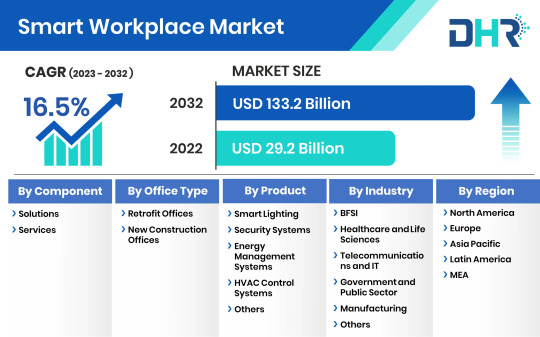
Request Sample Report: https://datahorizzonresearch.com/request-sample-pdf/smart-workplace-market-2646
Recent developments in the smart workplace market include:
1. Remote Work Enablement: With the shift towards remote and hybrid work models accelerated by the COVID-19 pandemic, smart workplace solutions have focused on enabling seamless collaboration, communication, and productivity regardless of physical location.
2. AI-Powered Insights: Advanced analytics and AI algorithms are being increasingly leveraged to derive actionable insights from workplace data. These insights help organizations optimize space utilization, energy consumption, and resource allocation, leading to cost savings and improved efficiency.
3. Health and Wellness Initiatives: Amidst growing concerns about employee well-being, smart workplace solutions are integrating features to monitor air quality, temperature, lighting, and noise levels to create healthier and more comfortable work environments.
4. Contactless Technologies: To minimize physical contact and enhance safety in the post-pandemic workplace, contactless technologies such as touchless access control systems, voice-activated interfaces, and gesture-based controls are gaining traction.
5. Integration of IoT Ecosystems: The convergence of various IoT devices and platforms within the smart workplace ecosystem is facilitating seamless connectivity and interoperability, allowing organizations to deploy integrated solutions that enhance overall operational efficiency.
Top Companies are:
· Schneider Electric
· Wipro
· Cisco Systems Inc.
· Honeywell International Inc.
· Siemens AG
· Johnson Controls International PLC
· Spacewell
· Sogeti
· Fujitsu Limited
· Lutron Electronics Company
Market Segmentations:
By Component (2023–2032)
Solution
Service
By Office Type (2023–2032)
Retrofit Offices
New Construction Offices
By Product (2023–2032)
Smart Lighting
Security Systems
Energy Management Systems
HVAC Control Systems
Others
By Industry (2023–2032)
BFSI
Healthcare and Life Sciences
Telecommunications and IT
Government and Public Sector
Manufacturing
Others
Regional Analysis:
North America, spearheaded by the United States, commands a significant portion of the smart workplace market share. According to insights from Protected Trust, a leading cloud security company in the U.S., a notable trend is emerging where 63% of companies are investing in the creation of small conference and meeting rooms, while 56% are expanding with larger conference spaces, integrating advanced collaboration tools to foster enhanced employee interaction and teamwork.
Moreover, the region boasts a robust digital infrastructure, facilitating swift adoption and implementation of cutting-edge technological solutions, thus solidifying its position as a primary user and innovator within the smart workplace ecosystem.
Key highlights of the report include:
1. The report delivers thorough Market analysis, furnishing valuable insights to guide strategic decision-making.
2. The comprehensive research outlined in the study enhances the depth of your presentations and marketing strategies.
3. By offering crucial insights into key market competitors, the study empowers businesses with a strategic edge.
4. It delivers a precise assessment of evolving market dynamics, ensuring readers stay abreast of the latest industry trends.
5. With meticulous breakdowns of various market niches, the report facilitates informed decision-making processes.
0 notes
Text

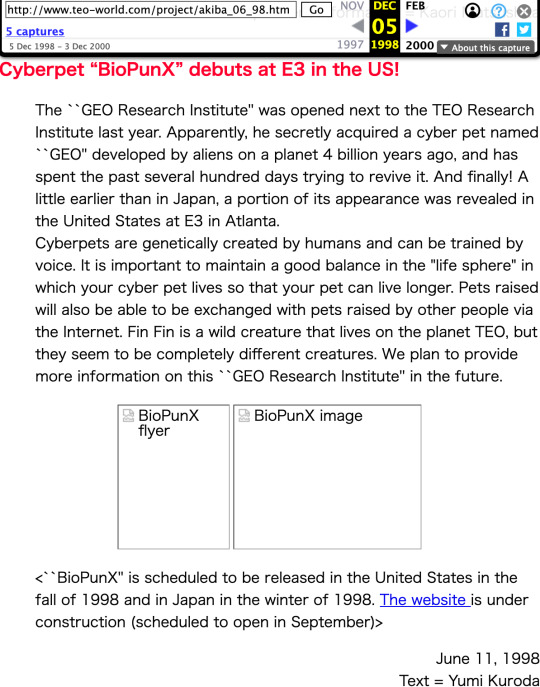

During E3 '98, Fujitsu announced a TEO spinoff called "BioPunX".

It never released and the trademark was abandoned in 2002. Very little evidence of this game exists beyond a few publications.

"The latest product that is intended to appeal more to men is the computer game " BioPunX "."
- Wirtschaftswoche - Volume 52, Issues 46-49 - Page 116 (1998)


"This is a simulation program, featuring four "BioPunX" creatures. Each has a unique personality and attitude. The idea is to train them so they can complete a mission. Not yet reviewed."
- Complete Sourcebook on Children's Software (1999 and 2001)
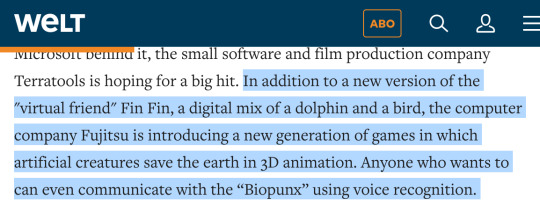
"...a new generation of games in which artificial creatures save the earth in 3D animation. Anyone who wants to can even communicate with the "Biopunx" using voice recognition."
- DIE WELT: Mehr Glück im Computerspiel (27.08.1998)
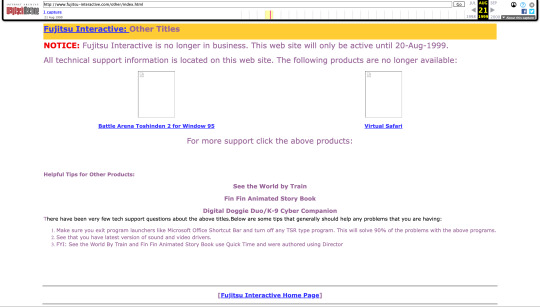

In 1999, Fujitsu Interactive went out of business. However, Shigetoshi Akasaki, the president of Fujitsu Interactive, announced that the game was still being worked on in a GameSpot article a year later.
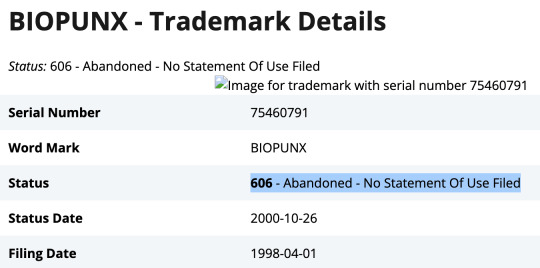
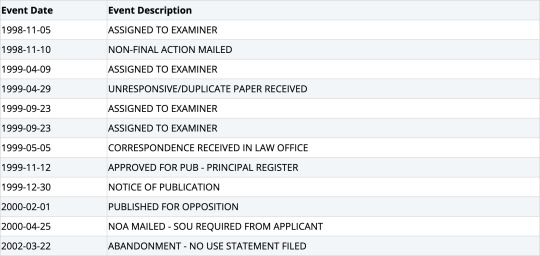
Two years after this announcement, the "BioPunX" trademark was officially abandoned.

In 2013, the rights to "Biopunks" and "Biopunx" were acquired by some German lawyers who have held onto it ever since.

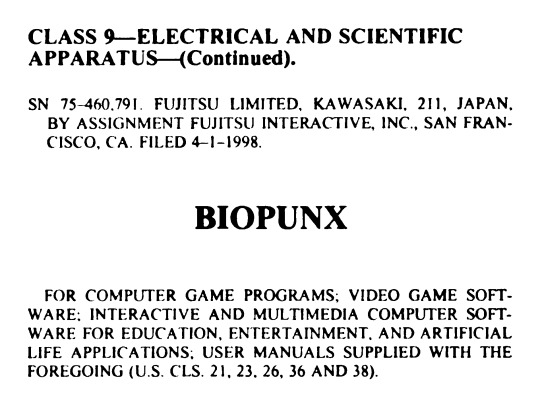

This wasn't really Fin Fin related but I just wanted to talk about this because nobody has compiled info about this game anywhere else.
#BioPunX#fin fin#finfin#fin fin on teo the magic planet#finfin on teo the magic planet#teo the other earth#teo the magic planet#fujitsu
44 notes
·
View notes
Text
AIMA Professional Development | Enhancing Management Skills & Competencies
GAMP is designed to help business leaders get insights into the emerging trends/business models and will focus on open innovation strategies that will help deal with the current VUCA environment also prepare for future scenarios. The format of the programme includes Case Discussions, Presentations, Executive Panels and visits to and interaction with the top management teams of some of the most innovative companies and institutions in US Silicon Valley. Some companies visited in the past include NVidia, Chevron, Paypal, Standard Chartered Bank, Wells Fargo Bank, PG&E, DuPont Innovation Center, Calpine Corporation, Cisco Systems, Wipro, IBM Almaden Research, Plug & Play Innovation Center, Fujitsu Laboratories, Berkeley SkyDeck, UC Berkeley Campus amongst others. For More Information Please Visit Our Website:-
0 notes
Text
Japan Smart Cities Market: Global Industry Analysis and Forecast 2023 – 2030

Japan's Smart Cities are Expected to Grow at a Significant Growth Rate, and the Forecast Period is 2023-2030, Considering the Base Year as 2022.
Japan has been aggressively attempting to turn its cities into smart cities by incorporating cutting-edge technology and data solutions to enhance citizen quality of life and local services. The nation has made significant investments in 5G networks, Internet of Things (IoT) devices, and high-speed internet connections as part of its technology infrastructure investments. These technologies are essential for gathering and evaluating data from the city's diverse sources.
Japan's smart city initiatives are mostly focused on sustainable energy solutions, with an emphasis on the advancement of renewable energy sources like solar and wind power in addition to the implementation of smart grid technologies to improve energy distribution. Furthermore, smart transit systems are being used by Japanese towns to lessen traffic jams and enhance public transportation, all in an effort to increase mobility and traffic. This involves encouraging the use of electric vehicles and integrating intelligent traffic management.
In Japan, planning and urban design are crucial to the development of smart cities. The nation employs data analytics to develop energy-efficient buildings, enhance urban planning, and generate green spaces. Real-time data on a range of urban elements, including trash management, water use, energy consumption, and air quality, is gathered through the widespread use of IoT devices and sensor networks.
Japan emphasizes the significance of citizen interaction for developing smart cities. The objective is to use digital platforms, feedback mechanisms, and participatory planning to involve inhabitants in decision-making. Furthermore, the nation gives top priority to deploying smart technologies for public safety, security, surveillance, emergency coordination, and disaster management strategy deployment.
Get Full PDF Sample Copy of Report: (Including Full TOC, List of Tables & Figures, Chart) @
Updated Version 2024 is available our Sample Report May Includes the:
Scope For 2024
Brief Introduction to the research report.
Table of Contents (Scope covered as a part of the study)
Top players in the market
Research framework (structure of the report)
Research methodology adopted by Worldwide Market Reports
Leading players involved in the Japan Smart Cities Market include:
Panasonic Corporation (Japan), Hitachi Ltd. (Japan), Mitsubishi Electric Corporation (Japan), Siemens AG (Germany), Toshiba Corporation (Japan), NEC Corporation (Japan), Fujitsu Limited (Japan), Sumitomo Mitsui Construction Co., Ltd. (Japan), NTT Group (Japan), Schneider Electric SE (France), Toyota Motor Corporation (Japan), Ericsson (Sweden), ABB Group (Switzerland), SoftBank Group Corp. (Japan), Honda Motor Co. Ltd. (Japan), Shimizu Corporation (Japan), Sekisui House Ltd. (Japan), Daikin Industries Ltd. (Japan), ORIX Corporation (Japan), Yokogawa Electric Corporation (Japan), and Other Major Players
Moreover, the report includes significant chapters such as Patent Analysis, Regulatory Framework, Technology Roadmap, BCG Matrix, Heat Map Analysis, Price Trend Analysis, and Investment Analysis which help to understand the market direction and movement in the current and upcoming years.
If You Have Any Query Japan Smart Cities Market Report, Visit:
https://pristineintelligence.com/inquiry/japan-smart-cities-market-113
Segmentation of Japan Smart Cities Market:
By Solution and Service
Smart Mobility Management
Smart Public Safety
Smart Healthcare
Smart Building
Smart Utilities
Others
By Component
Hardware
Software
Service
By Level
Emerging Smart Cities
Developing Smart Cities
Mature Smart Cities
By End-user
Government & Municipalities
Transportation & Logistics
Energy & Utilities
Healthcare
Education
Others
Importance of the Report :
• Qualitative and quantitative analysis of current trends, dynamics and estimates;
• Provides additional highlights and key points on various Japan Smart Cities market segments and their impact in the coming years.
• The sample report includes the latest drivers and trends in the Japan Smart Cities market.
• The report analyzes the market competitive environment and provides information about several market vendors.
• The report provides forecasts of future trends and changes in consumer behavior.
• Comprehensive fragmentation by product type, end use and geography.
• The study identifies many growth opportunities in the global Japan Smart Cities market.
• The market study also highlights the expected revenue growth of the Japan Smart Cities market.
Our study encompasses major growth determinants and drivers, along with extensive segmentation areas. Through in-depth analysis of supply and sales channels, including upstream and downstream fundamentals, we present a complete market ecosystem.
If you require any specific information that is not covered currently within the scope of the report, we will provide the same as a part of the customization.
Acquire This Reports: -
https://pristineintelligence.com/buy-now/113
About Us:
We are technocratic market research and consulting company that provides comprehensive and data-driven market insights. We hold the expertise in demand analysis and estimation of multidomain industries with encyclopedic competitive and landscape analysis. Also, our in-depth macro-economic analysis gives a bird's eye view of a market to our esteemed client. Our team at Pristine Intelligence focuses on result-oriented methodologies which are based on historic and present data to produce authentic foretelling about the industry. Pristine Intelligence's extensive studies help our clients to make righteous decisions that make a positive impact on their business. Our customer-oriented business model firmly follows satisfactory service through which our brand name is recognized in the market.
Contact Us:
Office No 101, Saudamini Commercial Complex,
Right Bhusari Colony,
Kothrud, Pune,
Maharashtra, India - 411038 (+1) 773 382 1049 +91 - 81800 - 96367
Email: [email protected]
#IoT (Internet of Things)#Urban Mobility#Smart Infrastructure#DigitalGovernance#BigDataandAnalytics#Renewable Energy#5G Technology#Cybersecurity#Environmental Sustainability#Smart Healthcare#Smart Education#Waste Management#Smart Water Management#Augmented Reality (AR) and Virtual Reality (VR)#AI (Artificial Intelligence)#Blockchain#SmartSensors#SmartAgriculture
0 notes